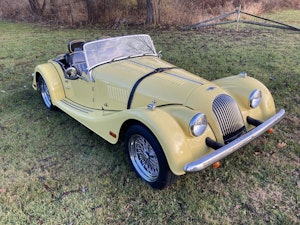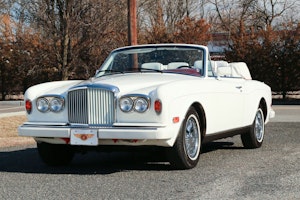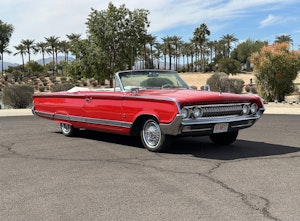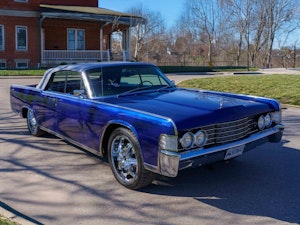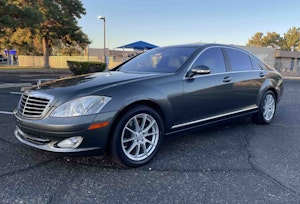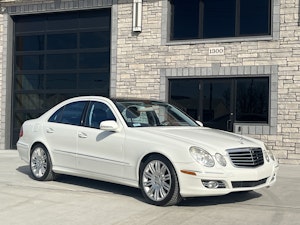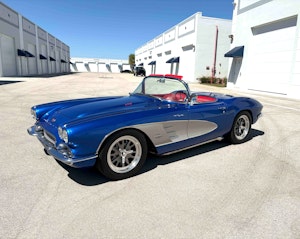Media | Articles
Meet the bad Mitsubishi wagon Canada can enjoy years before the U.S.
It’s become something of a running joke that Canada is America’s hat. In terms of car collecting, the country could very well be America’s crystal ball. Not that car enthusiasts north of the border know something that their U.S. neighbors don’t, of course. They’re just living in the future. Sort of.
Since foreign-market cars are eligible for import after fifteen years—rather than after 25, as in the states—Canada is a decade ahead of the U.S. when it comes to European and Japanese metal. There are some pretty cool wagons roaming around the frozen north, and this Mitsubishi is one of the best: a 2006 Lancer Evolution IX wagon, imported into Vancouver, British Columbia and up for sale. Remember when Mitsubishi used to be cool? Lancer “Evos” were part of that street cred, combining rally-winning heritage with on-tarmac performance that was always just that little bit sharper than that of Subaru’s STI. Lancer Evo IX values have ticked up slightly since fall of last year, caught in a rising tide. Mitsubishi’s current milquetoast range and Subaru’s decision to axe the STI should only enhance the boxy wagons’ appeal. Toyota’s Grrr-olla hatch looks pretty tempting for a modern, rally-engined machine, but cars from the mid-2000s offer a mechanical flavor of feedback that’s not easy to replicate today. Though Lancer Evos are fitted with all manner of clever differentials, theirs is more of an analog driving experience rather than a digitally enhanced one.
Whether or not the Lancer Evo evokes nostalgia in you, the formula will be familiar: big engine, small car. In 1992 Mitsubishi took the powertrain from the larger Galant VR-4 and stuffed it into the smaller, lighter Lancer. Pre-Evo Lancers already boasted a rallying pedigree, and it would only grow richer as the breed captured podium after podium. Finnish driver Tommi Mäkinen cemented the nameplate’s legacy by winning the World Rally Championship (WRC) driver’s title four times between 1996 and 1999. Unfortunately for those in North America, “World Rally Championship” was as inaccurate a name as baseball’s World Series.
If you were a fan of rallying in North America, it wasn’t easy to watch unobtainable Mitsubishis and Subarus getting going hammer and tongs through the stages, especially if you couldn’t afford the expense of flying across the Atlantic to spectate in person. However, this era was also marked by the rise of the internet, which meant you could download grainy videos of Tommi shredding gravel in his red and white Lancer. If you were lucky enough to receive a Playstation, you could use a digital Evo to slice up some digital tarmac in the Gran Turismo games.
Marketplace
Buy and sell classics with confidence
U.S. enthusiasts could not, however, hit the road in a real-world Evo. At least, not until 2002, when the Evo VIII arrived in the U.S., its arrival perhaps spurred by the success of the American-market WRX the year prior. Slightly detuned compared to the Japanese version, the eighth-generation Evo was worth the wait. Reviewers praised its quick steering, lively chassis, and all-wheel-drive confidence. It was about as quick as an contemporary M3 (E46) for a little over half the BMW’s price. Granted, the Mitsubishi was a lot less refined—but if performance was your priority, the diamond-star brand had a car for you.
However, let’s suppose you needed something that could both haul a stroller and harass Bavarians at a track day. No such luck. The Lancer Evo was fast and fun, but its practicality was limited. Subarus were sloppier but also more comfortable, so the WRX won out in the long run. The Lancer’s situation in the U.S. was absolutely not helped by Mitsubishi running much of the rest of its lineup into the ground.
If you lived in Japan, Mitsubishi had an offering just for you, the hotshoe parent. Built for three model years from 2005 to 2007, the Evo VIII Wagon is one of the coolest special editions Mitsubishi ever made. It would become one of the last truly interesting JDM-only models.
Officially, Mitsubishi built 2500 Lancer Evo VIII wagons, though some enthusiasts suggest the number is closer to 3000. Roughly half were fitted with six-speed manual gearboxes, the other half with five-speed automatics. The manual-equipped models were available in two trims: a standard GT with Recaro seats and 18-inch wheels, and the MR, which added Bilstein dampers and some cosmetic upgrades. The stick-shift cars also received Mitsubishi’s MIVEC variable-valve timing upgrade. The engines of the automatic models wore a slightly smaller turbocharger for quicker low-end response.
The Evo IX was overall easier to live with than the raucous Evo VIII, and in wagon form, it is particularly compelling. The angular looks have aged well. The sedan is a little lighter, but the wagon’s roughly 50-pound weight penalty is mostly to the rear, which actually improves weight distribution.
This one is a GT-A and yes, there’s a child seat in back. It belongs to Adam Trinder, a local machinist who has added a few sympathetic (and easily reversible) modifications, repainted the car’s original faded exterior, and refurbished the interior. He has other projects in mind—he once built a Mini with a mid-mounted Kawasaki 1300cc engine, to give you an idea of his tastes—and has put his Evo up for sale.
The earliest versions Evo VIII wagons were built in 2005, which means they won’t be legal to register in the U.S. until 2030. As the import window approaches, their values could rise. A similar hot-wagon example is Audi’s RS2: Values of wagons ranging from concours (#1) to daily-driver (#3) condition jumped an average of 26 percent from May 2020 to September 2020—about 25 years after the 1994/1995 model years—with another smaller increase about a year later. Hagerty’s valuation team has also seen similar, though less distinct, increases in price guide values for vehicles such as the Nissan Skyline GT-R as its import window approaches.
The Evo wagon also represents a bookend on the JDM market. 1990s Japan was awash in desirable cars we couldn’t get, from Skylines to Subarus. As the 2000s wore on, most of the performance offerings were available on both sides of the Pacific. With the slight asterisk that is the GR Yaris, there are few JDM products to inflame the jealousy of U.S. buyers.
However, if you’re a resident of America’s hat (or at least have a holiday igloo up here), here’s your chance. The Evo wagon is a fun, fast car you can drive right now. Plus, it may appreciate as it approaches U.S. importability. Pretty sweet ride there, eh bud?
Check out the Hagerty Media homepage so you don’t miss a single story, or better yet, bookmark us.



